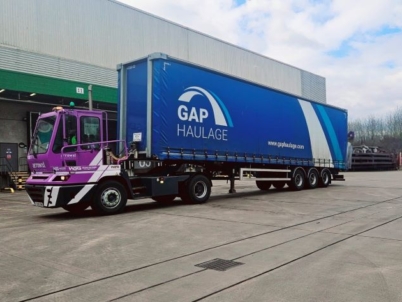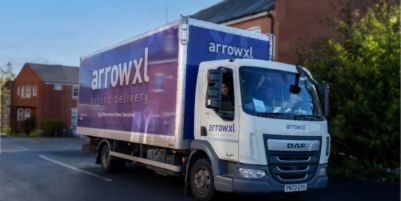-
Nutrivend selects Forterro’s Orderwise to support online expansion and streamline operations - April 11, 2025
-
ARROWXL LAUNCHES AMBITIOUS ZERO WASTE ROADMAP - April 8, 2025
-
THE BCMPA’S NEW CAMPAIGN DRIVES OUTSOURCING SUCCESS IN Q1 - April 7, 2025
-
BLACKOUT TECHNOLOGIES TARGETS TELEMATICS-INTEGRATED MOBILE DEVICE BLOCKING TO COMBAT SMARTPHONE DISTRACTION - April 1, 2025
-
Sparck Technologies awarded Royal designation - March 27, 2025
-
OpenADR Alliance announces first OpenADR 3.0 certified products with EVoke Systems, E.ON Energy and Universal Devices - March 25, 2025
-
Growing fulfilment and contract packer appoints new Managing Director - March 25, 2025
-
When is it time to invest in a WMS? Understanding the key trigger points - March 25, 2025
-
eCapital helps Vantage Recruitment on its journey to financial success - March 24, 2025
-
Hugo Beck Celebrates 70 Years of Packaging Innovation with Open House Events - March 20, 2025
The worldwide land transport sector has undergone significant changes in recent times. Disruptive events, notably the global shock of the COVID-19 pandemic, have pushed businesses to adapt.
While many sectors are still recovering post-pandemic, land transport has showcased notable advancements. Interestingly, while some sectors faced downturns post-2019, the road transport industry is set to burgeon to over $130 billion in the next five years.
This remarkable transition paves the way for freight and logistics companies to significantly improve their operations and find new growth avenues.
What are the Factors Fueling Market Growth?
Since the pandemic’s peak, the land transport sector has witnessed remarkable growth, largely due to the e-commerce boom. This led to significant demand from overseas and local warehouses, increasing strain on transportation systems.
Parcel companies, LTL carriers, and independent couriers have had to adapt rapidly to this surge. Adopting innovative web-based solutions and advanced technologies has accelerated growth and revenue potential for these companies.
These investments have enhanced communication and provided valuable data-driven insights to streamline their operations. As e-commerce continues to thrive, transport providers face the challenge of delivering faster, cost-effective services.
Fortunately, the prospect of autonomous vehicles and drone deliveries indicates a promising future for those embracing transformative technologies in logistics.
Current Market Trends: The Influencers
As technology advances, it paves the way for industry disruption, and land transportation is currently at this crossroads. IoT platforms, for instance, have transformed freight companies by enabling real-time tracking and route enhancement.
Similarly, AI technology has reshaped business decision-making processes, and its versatile applications streamline various operations by eliminating tedious tasks.
Environmental concerns have long affected the freight sector. But instead of avoiding these global duties, freight companies can genuinely contribute. By refining supply chains and adopting sustainable practices, land transport businesses can significantly lower their carbon impact, promoting a greener future for all.
Challenges That Need to Be Addressed
While there is no storage of opportunities for land transportation companies, several pressing issues still demand attention.
Key challenges include:
- Fuel Cost Surge: Escalating fuel prices strain freight businesses’ profit margins. This trend doesn’t seem to be stabilizing soon. Solutions might include transitioning to greener vehicles and optimizing route strategies for efficiency.
- Global Pricing Instability: The recent surge in the cost of goods and unpredictable supply and demand cycles make it challenging for transportation companies to anticipate trends and set forecasts. These companies must adapt quickly and maintain flexibility to navigate the ever-changing market dynamics.
- Evolving Customer Demands: Modern consumers expect faster deliveries at lower costs. This mandates businesses to innovate, ensuring competitive pricing without skimping on service quality.
Transforming Industry Challenges into Exciting Opportunities
In the face of the land transport industry’s hurdles, proactive measures to identify and take advantage of new opportunities become crucial. Here’s how manufacturers are tackling these challenges:
Nearshoring is Gaining Popularity
Manufacturers are increasingly turning to nearshoring, which involves shifting production from overseas locations to closer regions. This strategy, becoming prominent among US manufacturers, aims to cut transportation costs, shrink lead times, and boost supply chain adaptability.
Relocating production closer to consumer markets helps to counter prolonged delays and disruptions typically linked with logistics. This move saves on transportation and presents benefits like shorter lead times and reduced manufacturing costs when nearshoring to places like Mexico or Canada.
Customs Brokerage Services Are Streamlining Cross-Border Shipments
While nearshoring optimizes costs, addressing the intricacies of cross-border logistics remains a challenge. This is where customs brokerage services step in.
Manufacturers simplify the intricate task of cross-border transfers by employing customs brokers knowledgeable in local regulatory norms. These services encompass efficient border crossing, managing compliant paperwork, and facilitating smooth dealings with customs staff.
Real-Time Freight Rates Are Reducing Spending
Utilizing cutting-edge technology, shippers can instantly find shipping rates from a wide range of carriers using a single platform.
These real-time comparisons offer clearer insight into supply chain expenses, empowering businesses with better budgetary decision-making.
These real-time insights provide quick visibility into costs, eliminating the need for bargaining and aiding in efficient transportation planning. During peak demand seasons, these tools help secure reliable shipment options, enhancing client satisfaction and positively impacting profit margins.
Unlock the Full Potential of Land Transport Opportunities
As the land transport industry progresses, it faces several challenges. However, these challenges also bring opportunities for positive change. Businesses can optimize their processes and reduce costs by investing in customer brokerage services, capitalizing on nearshoring opportunities, and utilizing real-time freight comparison solutions. These are just a few ways to streamline operations while keeping expenses in check.
By leveraging these strategies, companies in the land transport industry can substantially enhance their operations, guaranteeing quick and cost-effective deliveries for customers. Through meticulous planning and deliberate execution, manufacturers and shippers alike can maximize the potential of current land transportation opportunities.
Author Bio:
Joe Jaska
Joe Jaska is the Head of Land Product for Region Americas at DB Schenker, a role he has held since early 2020. He has full P&L responsibilities for 24 countries in North, Central, and South America, leading land transport to ensure quick and reliable delivery to all major destinations across the continent. Joe ensures full or partial truckloads move across the continent or across borders without delay.
































